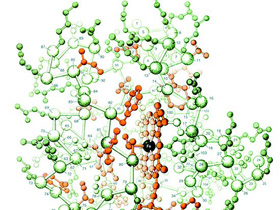Although Darwinists are no longer as vocal as they once were, they still continue to test the waters from time to time. Indeed, a new chapter was recently added to the long list of Darwinist errors. That was the claim that ‘chain reactions inside the cell can occur in the absence of enzymes.’
In this article we shall reveal that the idea in question has nothing to do with being scientific and that, on the contrary, it was an interesting but amateurishly designed deception that even someone with an insufficient knowledge of basic biology could immediately realize.
First and foremost, let us make it clear that evolutionists are also well aware that the presence of proteins, essentially working nano-engines, is essential for life. For 100 years or so they have been combining chemical molecules in the laboratory and trying to inculcate the idea that proteins, which are essential for the survival of life inside the cell, can come into being spontaneously. However, these endeavors are all in vain. This is an idea what was theorized by Alexander Oparin and later attempted to be proved through the Urey-Miller experimental apparatus; all those endeavors have all failed.
Aware that there can be no life without proteins, Darwinists recently came up with a new claim, the illusory idea that life had no need of proteins in the beginning.
“Let there be no protein, but we must have sugars”
What inspired the Darwinist scenario set out below is the discovery of chemical chain reactions that break down glycose and convert it into pyruvate with no need of the cell and enzymes. This scenario was prepared postulated on the hypothesis that ‘the protein dilemma facing evolution has been solved,’ because this mythical account maintains that there is no need for protein for life to begin.
We are describing this hard to believe tale directly from a pro-Darwinist source, without adding any exaggeration or interpretation:
1. First of all, metabolic chain reactions took place thanks to metal ions in warm water springs in the depths of the ocean.
2. Subsequently, something that we cannot describe as a ‘cell’ and that was nothing more than a balloon of fat may have come along and enveloped them.
3. In this way, the first things may have come into possession of and been surrounded by membranes through these metabolic pathways.
4. The primitive ‘first cell’ may have come into being in this way.
5. These metabolic pathways may have become better and more sensitive as enzymes in the same environment supposedly (our emphasis) evolved.
(This description is taken from an evolutionist source, with no exaggeration on our part. See http://www.newscientist.com/article/dn25471-spark-of-life-metabolism-appears-in-lab-without-cells.html#.VWBxpmCFbzL)
This account, founded entirely on assumptions and consisting entirely of ‘maybes,’ is clearly totally divorced from the scientific realities. As in all other such instances, with the tale of a fat balloon finding ‘metabolic chain reactions’ to hand and then laying out claims based on them saying, "Just what I was looking for!" once more proves the breadth of the evolutionists' dream world. Although such accounts may at first sight appear to be based on one true fact, they are in fact based on the production of countless myths, in other words, they are totally deceptive.
Watch out for deception!
Yes, the latest research has shown that when heat is applied to an environment containing sugar and metal ions such as iron and phosphate, the glucose molecule breaks down and pyruvate is obtained as an end-product, together with other by-products, just as seen on glycolysis and pentose-phosphate pathways. (Pyruvate, also known as pyruvic acid, is the final product resulting from the glycolysis stage of aerobic or non-aerobic respiration.) Accordingly, a molecule such as glycose breaks down in hot water in the presence of various metal ions.
Photosynthesis is the source of our hero sugar
Looking closely, the fairy tale in question needs carbohydrate production right from the start, and the first chemical used is glucose. Yet glucose is a carbon compound that can only be produced in the world through photosynthesis.
Plant cells and algae produce sugar by means of photosynthesis in a way that cannot be replicated in even the most advanced laboratories of our day. It is therefore irrational to speak of the glucose molecule in the absence of a fully formed and flawless cell that makes photosynthesis. To summarize, photosynthesis and sugars exist if these immaculate cells exist, but not if they do not.
We now know that life on Earth began with algae making photosynthesis. Fossils of blue-green algae cells that lived 3.2 billion years ago and have been preserved undamaged to the present day show that life began instantaneously at that time, and that life -forms have come down to the present unchanged.
The End of Another Tale of Evolution
To reiterate, Darwinists came up with the idea that ‘there is no need of enzymes to break down sugars,’ in other words, they suggested that sugars can be broken down in the absence of the cell. However, they have forgotten this very important scientific fact; sugars can only come into existence through photosynthesis, that is to say, in order to be able to speak of sugars at all, a cell making photosynthesis has to exist. And photosynthesis is a highly complex process, many stages of which are not fully understood even today.
As we have seen, yet another Darwinist myth reveals that evolution is a self-refuting deception.
Inanimate substances cannot create life. Life can only come from life. Clearly, the cell and life were immaculately created out of nothing, in the most complex form, with all their substructures instantaneously by Omniscient, Infinitely Powerful God.
References:
Non‐enzymatic glycolysis and pentose phosphate pathway‐like reactions in a plausible Archean ocean, Markus A Keller, Alexandra V Turchyn, Markus Ralser, Molecular Systems Biology (2014) 10: 725 (http://msb.embopress.org/content/10/4/725)
Spark of life: Metabolism appears in lab without cells, Linda Geddes, NewScientist, 25 April 2014
(http://www.newscientist.com/article/dn25471-spark-of-life-metabolism-appears-in-lab-without-cells.html#.VWBZImCFbzJ


